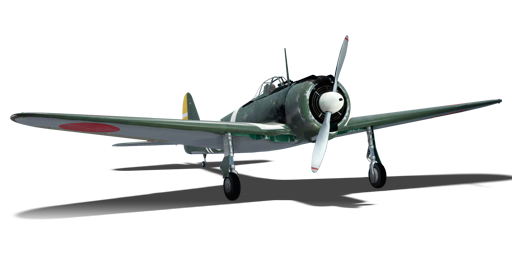

Aviation
Ki-43-I
I
Rank
AB
2.0
RB
2.7
SB
2.3
Battle rating
Japan
Research country
Fighter
Main role
4,000

Research
2,100

Purchase
General information
Flight performance
Max speed
at 4,000 m
495461516476 km/h
Rate of Climb
15.311.919.611.9 m/s
Turn time
141513.414.6 s
Max altitude
9,000 m
Takeoff Run
120 m
Landing
flaps
flaps
Take-off
flaps
flaps
Combat
flaps
flaps
Air
brake
brake
General characteristics
Crew
1 person
Engine
Length
8.9 m
Wingspan
11.4 m
Wing Loading
101 kg/m²
Weight:
Base weight
1.821.871.771.86 t
Fuel in main tanks
0.41 t (1h 38m)
Limits:
Max Speed Limit (IAS)
630 km/h
Mach Number Limit
0.65 M
G limit
≈ -5/10 G
Flap Speed Limit (IAS)
L / T / C
250 / 373 / 417 km/h
Gear Speed Limit (IAS)
300 km/h
Offensive armament
2 × 7.7 mm Type 89 machine gun
Ammunition
1,000 rounds
Fire rate
1,100 shots/min
One-second Burst Mass
0.19 kg
| Belt | Belt filling | Armor penetration (mm) at a distance: | |||||
|---|---|---|---|---|---|---|---|
| 10 m | 100 m | 500 m | 1000 m | 1500 m | 2000 m | ||
| T/AP/IAI/AP/I | 13 | 12 | 7 | 3 | 2 | 0 | |
| T/AP/IAI/AP | 13 | 12 | 7 | 3 | 2 | 0 | |
| T/T/T/AP | 13 | 12 | 7 | 3 | 2 | 0 | |
| I/AP/AP/AP/IAI | 13 | 12 | 7 | 3 | 2 | 0 | |
12.7 mm Ho-103 machine gun
Ammunition
270 rounds
Fire rate
900 shots/min
One-second Burst Mass
0.53 kg
| Belt | Belt filling | Armor penetration (mm) at a distance: | |||||
|---|---|---|---|---|---|---|---|
| 10 m | 100 m | 500 m | 1000 m | 1500 m | 2000 m | ||
| AP-T/AP/HEF-I | 21 | 19 | 13 | 7 | 4 | 3 | |
| AP-T/HEF-I/AP/HEF-I | 21 | 19 | 13 | 7 | 4 | 3 | |
| AP-T/HEF-I/HEF-I/HEF-I | 21 | 19 | 13 | 7 | 4 | 3 | |
| AP-T/AP/AP-T | 21 | 19 | 13 | 7 | 4 | 3 | |
| AP/HEF-I/HEF-I/HEF-I | 21 | 19 | 13 | 7 | 4 | 3 | |
7.7 mm Type 89 machine gun
Ammunition
500 rounds
Fire rate
1,100 shots/min
One-second Burst Mass
0.19 kg
| Belt | Belt filling | Armor penetration (mm) at a distance: | |||||
|---|---|---|---|---|---|---|---|
| 10 m | 100 m | 500 m | 1000 m | 1500 m | 2000 m | ||
| T/AP/IAI/AP/I | 13 | 12 | 7 | 3 | 2 | 0 | |
| T/AP/IAI/AP | 13 | 12 | 7 | 3 | 2 | 0 | |
| T/T/T/AP | 13 | 12 | 7 | 3 | 2 | 0 | |
| I/AP/AP/AP/IAI | 13 | 12 | 7 | 3 | 2 | 0 | |
2 × 12.7 mm Ho-103 machine gun
Ammunition
540 rounds
Fire rate
900 shots/min
One-second Burst Mass
0.53 kg
| Belt | Belt filling | Armor penetration (mm) at a distance: | |||||
|---|---|---|---|---|---|---|---|
| 10 m | 100 m | 500 m | 1000 m | 1500 m | 2000 m | ||
| AP-T/AP/HEF-I | 21 | 19 | 13 | 7 | 4 | 3 | |
| AP-T/HEF-I/AP/HEF-I | 21 | 19 | 13 | 7 | 4 | 3 | |
| AP-T/HEF-I/HEF-I/HEF-I | 21 | 19 | 13 | 7 | 4 | 3 | |
| AP-T/AP/AP-T | 21 | 19 | 13 | 7 | 4 | 3 | |
| AP/HEF-I/HEF-I/HEF-I | 21 | 19 | 13 | 7 | 4 | 3 | |
Economy
Repair cost
Basic → Reference
AB
134 → 225 

RB
294 → 494 

SB
401 → 674 

Crew training
600 

Experts
2,100 

Aces
45 

Research Aces
110,000 

Reward multiplier
AB / RB / SB
10 / 30 / 60 % 

100 % 

Total cost of modifications
4,450 

2,680 

Talisman cost
300 

Research order:
Flight performance | |
|---|---|
Survivability |
|---|
Weaponry | |
|---|---|
Rating by players
You must play more than 3 battles for the last week and more than 10 battles in a vehicle to rate it.
Like:
34
Flight performance:
Not enough ratings
Survivability:
Not enough ratings
Aerial combat:
Not enough ratings
Ground attack:
Not enough ratings
Balance:
Not enough ratings
Tips & Tricks
This space is currently empty
Do you know any interesting vehicle features?
Loading...
No articles about this vehicle yet
Become the first author and get rewards!
Write a guide, tell about interesting historical facts, make a tutorial or simply an interesting post.
No more content
